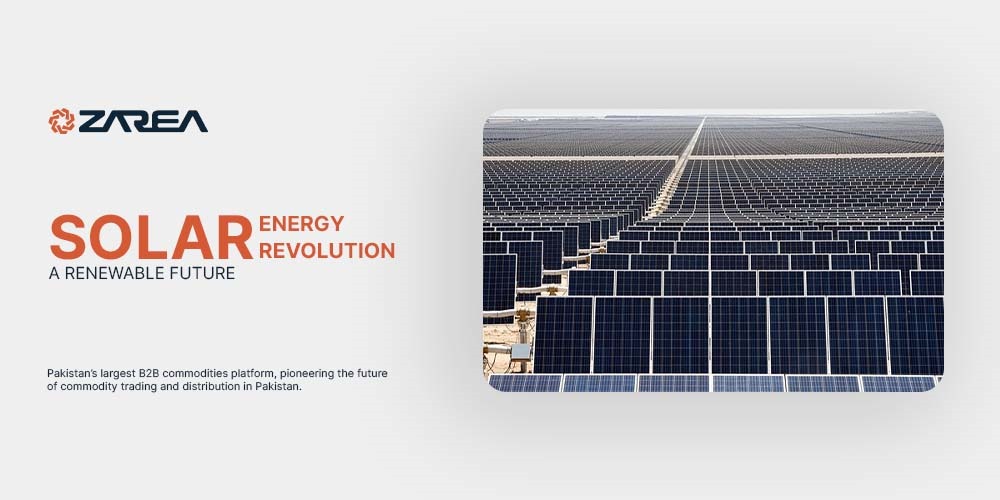Introduction – Solar Energy Revolution:
The solar energy revolution has advanced in the energy sector. This also offers a cleaner and more sustainable energy option for the future. A solar boom has attained unprecedented levels in Pakistan. It also ignited what certain experts refer to as one of the swiftest solar transformations globally.
With rising environmental issues and a higher need for energy, the solar energy movement is influencing the future of sustainability. Due to technological progress, decreasing costs, and a worldwide move toward clean energy, solar energy has emerged as a crucial factor in the shift to renewable energy sources.
This article examines the significance of solar energy, its advantages, technological improvements, and its contribution to creating a sustainable future.
The Rise of Solar Energy:
While the world struggles with the energy crisis and the repercussions of COVID-19, solar energy in India flourishes, creating jobs and leading towards a cleaner, more sustainable future. Discover the newest advancements and enhanced efficiency in Solar energy system through out the last ten years.
In the span of four decades, solar energy has transformed from one of the priciest and least accessible electricity options to nearly the least expensive in many regions globally. Solar power is captured from the sun’s rays through photovoltaic (PV) panels or solar thermal technologies. In the last ten years, the uptake of solar energy has skyrocketed because of:
- Decreasing expenses of solar panels
- Incentives and subsidies provided by the government
- Progress in solar technology
- Increasing environmental worries about emissions from fossil fuels.
Global Solar Energy Growth
The International Energy Agency (IEA) reports that solar energy is the quickest expanding source of renewable power, as numerous nations target net-zero emissions by 2050. The cost-effectiveness and scalability of solar energy make it an appealing choice for residences, companies, and extensive industries.
Benefits of Solar Energy:
The solar revolution in Pakistan is achievable solely due to the dramatic decline in the cost of solar PV modules, which have dropped by 90% over the past 15 years. China, the leading manufacturer of solar PV modules globally, sells the majority of inexpensive solar panels.
For more than forty years, solar energy has transitioned from one of the priciest, inaccessible electricity options to nearly the least expensive in many regions globally.
In recent decades, the price of installing solar panels has significantly decreased by 70 percent, making the cost of solar panels in India a more accessible choice for homeowners and businesses.
1. Pure and Sustainable
In contrast to fossil fuels, solar energy is a limitless resource that generates no greenhouse gas emissions, which makes it one of the cleanest energy sources accessible.
2. Lowers Energy Expenses
Installing solar panels enables homeowners and businesses to produce their own electricity, greatly decreasing reliance on costly power grids. Net metering allows users to feed surplus energy back into the grid.
3. Reduced Maintenance Expenses
Solar power systems demand little upkeep, as PV panels typically last 25–30 years and only need occasional cleaning and check-ups.
4. Energy Autonomy
Nations investing in solar power decrease dependency on foreign fossil fuels, enhancing energy security and stability.
5. Employment Generation and Economic Expansion
The solar energy industry is creating millions of jobs globally in manufacturing, installation, and maintenance, enhancing economic development.
Innovations in Solar Energy Revolution:
The solar sector is advancing through state-of-the-art developments, enhancing the efficiency and accessibility of solar power.
The solar revolution in Pakistan is made possible by the dramatic decrease in the cost of solar PV modules, which have fallen by 90% over the past 15 years. The majority of inexpensive solar panels are provided by China, the leading global producer of solar PV modules.
1. Bifacial Solar Modules
These panels capture sunlight on both sides, boosting energy output by 10-20% relative to conventional panels.
2. Perovskite Photovoltaic Cells
A groundbreaking substitute for silicon solar cells, perovskite technology improves efficiency and decreases production expenses.
3. Floating Solar Installations
Floating solar panels on water surfaces enhance land utilization and boost efficiency by minimizing heat accumulation.
4. Solar Energy Storage and Batteries
Innovative lithium-ion and solid-state batteries enhance energy storage, enabling solar users to retain surplus energy for nighttime or overcast days.
5. Clear Solar Panels
Transparent solar windows of the future will turn buildings into independent energy generators.
Solar Energy in the Future:
As the world strives for net zero and fossil fuel consumption continues to decline, the need for the most effective renewable energy option will only grow. As solar energy is an infinite resource, we can anticipate significant advancements in the quest for ideal solar cell utilization. Perovskite might be the future when perfected, or it could serve as a bridge to another extraordinary material that has not yet been harnessed.
No matter what the future brings for perovskite and solar cells overall, one thing is clear – the limited energy efficiency of silicon solar cells indicates that the use of different solar cell materials will surely become more common.
As governments and companies pledge to sustainable development goals (SDGs), solar energy revolution is anticipated to lead the global energy sector. Forecasts for the upcoming ten years include:
- Growing utilization of solar energy in emerging countries
- Incorporating solar energy with intelligent grids and AI-powered energy management
- Growth of solar power initiatives in space
- Enhanced affordability for families and companies
Final Thoughts:
The solar energy transformation is leading towards a sustainable, affordable, and environmentally friendly future. With technological progress and increasing investments, solar energy will be essential in decreasing worldwide carbon emissions and securing a sustainable future.
Are you prepared to transition to solar energy? Discover the top solar options now and join the eco-friendly movement!
FAQ’s:
What is a solar energy revolution?
Individuals in Pakistan can now access and use solar energy at lower solar panel prices, effectively minimizing their carbon footprint. These enhancements have transformed the solar energy system, offering a cleaner and more sustainable source of energy for the future in the energy sector.
Referred to as a Solar energy Revolution or Solar Return, it’s a significant moment when you are once again filled with all the potential that your Sun sign provided you. Have you ever observed how full of energy you feel during your birthday? That is the direct effect of the Sun in the heavens linking to your birth Sun.
What does Elon Musk say about solar energy?
He stated, “When you grasp the Kardashev Scale, it becomes completely clear that nearly all energy production will be solar.” Musk elaborated that the sun generates sufficient energy to power the world multiple times—if we could just harness it effectively.
How has solar energy evolved?
Solar energy has progressed alongside technological advancements, improved efficiency, and heightened environmental consciousness. During the mid-20th century, photovoltaic technology allowed for direct conversion of electricity. Progress since then has lowered costs, increased global installations, and spurred innovation.
What is solar energy in simple words?
Solar energy refers to all forms of energy produced by the sun. Solar energy originates from nuclear fusion occurring within the sun. Fusion takes place when hydrogen atom protons collide forcefully in the sun’s core and merge to form a helium atom.
Who discovered solar energy?
It all started with Edmond Becquerel, a young physicist in France, who in 1839 noticed and identified the photovoltaic effect—a phenomenon that generates a voltage or electric current when subjected to light or radiant energy.
What are the sources of solar energy?
Solar energy functions by transforming sunlight into electricity. The sun produces two types of energy for our utilization – electric power and thermal energy. Both are produced using solar panels, which vary in scale from residential rooftops to ‘solar farms’ that cover extensive areas of rural land.


































